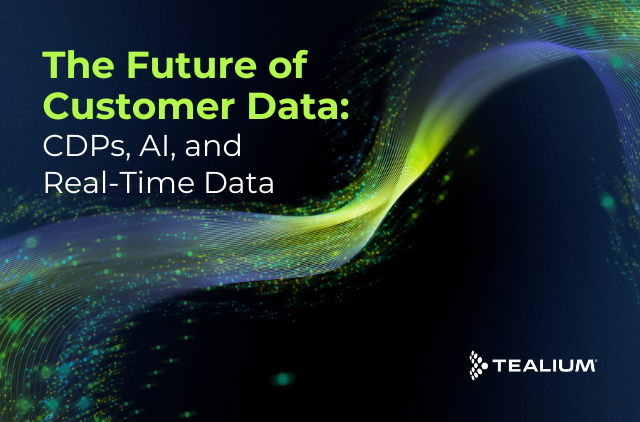Tealium and Merkle have come together to launch the Merkury integration, a best of breed connector that resolves the identity resolution debate by allowing Tealium users to create customer profiles that incorporate both deterministic and probabilistic customer data.
A Customer Data Platform (CDP) is designed to collect, connect and activate your customer data, preferably in real time. It becomes the single source of truth for an individual customer’s digital identity and allows sophisticated marketing automation and customer experience orchestration across all digital and many physical touchpoints.
However, before any advanced activation of customer data can occur, disparate customer data must be resolved into a persistent, unified customer database. As such, identity resolution is one of the key reasons CDPs came to exist. There are two distinct approaches to resolving customer data from multiple sources into a single customer profile – Deterministic (rules-based) or Probabilistic (algorithmic), and there are advantages to either approach.
The Difference Between Deterministic and Probabilistic Identity Resolution
Deterministic identity resolution relies on the exact (or near-exact) matching of PII or certain persistent identifiers to connect two customer profiles based on rules that have been set in the CDP. An example of an exact match might be a mobile number that appears in two customer records. In this simple case it can be assumed that this is the same customer and the two records combined or ‘stitched’ to create a single record. An example of a near-exact might be a terrestrial address where the street name is the same but an ‘st’ is used in one data source and ‘street’ is used in the next. Either way, there is a high degree of certainty that these records represent the same entity and can be combined along with the other attributes associated to the original customer profiles.
Deterministic identity resolution has several advantages.
Firstly, deterministic is the more conservative of the two approaches with a reduced probability of customer profiles being stitched together incorrectly and the ability to track exactly how the stitching has occurred. This low risk approach can be particularly useful for brands that need to ensure the right communication is sent to the right customer for the customer’s lifetime as ‘unstitching’ can become increasingly difficult as more records are inaccurately associated to the incorrectly-merged identity. In highly regulated industries such as financial services and healthcare, this is especially important. Consent must be respected across every source of data, and accurately assigned to the right person. Assigning data without consent, or assigning consent to the wrong person’s profile can pose many risks to the brand.
Secondly, the deterministic approach allows for real-time stitching of profiles whereas the probabilistic identity resolution process generally is delayed for up to 24 hours. This differentiation becomes significant if the CDP is being used for same/next-page onsite user experience personalization, or, for example, if the marketer wants to send a session abandoner email including dynamic content informed by the user journey on the same day. If you consider a flow where a user browses several category pages over a few sessions prior to revealing their email or other PII, it is important that the previously anonymous behavior is stitched to the newly created customer record in real-time, not up to a day later.
Probabilistic identity resolution attempts to replace static rules managed within the CDP with an algorithmic approach designed to stitch customer records that are highly likely to be the same person regardless of a lack of exact PII matches. This approach can increase the volume of identity matches thereby increasing the volume of personalized messaging that can be activated downstream. It can also reduce the workload associated to CDP rule-management sometimes experienced by marketers or their SI partners.
However, the risk of probabilistic identity resolution is overstitching, or bringing together two customer records that are not actually the same customer. Once two identities are incorrectly matched this can become particularly hard to ‘unstitch’ as each subsequent customer profile that is ingested will continue to view the customer record as a single customer and stitch further incorrect attributes as they become available.
The Black Box
A downside of probabilistic identity resolution can be a lack of control and visibility into the ways in which profiles are being stitched; due to the increasing scale of customer and ‘customer-to-be’ profiles held within the CDP there is no practical method of checking if profiles are being combined logically and, as algorithmic logic is not revealed to CDP customers, there is a significant amount of trust that needs to be placed in the programmatic algorithm, both initially and with each update that is made to the algorithm
Best of Both Worlds
At Tealium, we believe the best foundation for identity resolution starts with deterministic matching for three reasons:
- To support transparency in customer profile creation and maintenance
- To reduce privacy risk (incorrectly resolved identity can lead to incorrectly associated consent data)
- To protect the sacrosanctity of the customer profile, or golden record, from unintended profile stitching
Once a deterministic foundation has been created, supplementing with probabilistic matching can allow the brand to address specific use-cases, and to work with the methodology or probabilistic identity partner that works best for them.
As part of Tealium’s best-of-breed approach, real-time API & Javascript connectors have been created to allow for seamless access to additional probabilistic and 3rd party data via industry leading identity partners such as the newly announced integration with Merkle’s identity solution, Merkury. The Merkury connector allows Tealium customers to selectively enhance the CDP customer profile via a real-time connection to the Merkury solution.
The Merkury integration allows Tealium customers to enhance their customer profiles by:
Identification of Anonymous Site & App Traffic via the Merkury Identity Graph
The Digital Consumer Recognition (DCR) tag of Merkury allows brands to identify consented customers that have not yet revealed PII during the current session. This is done by associating PII available in Merkury to anonymous unique identifiers provided from Tealium via a tag placed on digital properties. Merkury provides confidence scores to help determine when the data provided should be stitched to the Tealium customer profile.
Probabilistic Normalization of PII and Terrestrial Data
Address data or PII made available to the CDP via form entry can be incomplete or slightly inaccurate due to human error. The Merkury connector allows for this data to be normalized probabilistically using fuzzy matching (Levenshtein distance) and by referencing the Merkury identity graph. This normalized data is returned to Tealium ensuring each profile’s address has been properly formatted to ensure consistency within the CDP and with downstream vendors.
3rd Party Data Append
The Merkury connector to Tealium also allows for additional attributes to be appended to the Tealium Customer Profile including intender, business and household data. This connection allows profiles to grow in real-time, revealing new PII, modifying existing PII and triggering the Merkury tag on website visits. Merkury will continue to update the profiles stored in Tealium with this 3rd party data that has been matched to the Merkury .
Clean Room
The Tealium API and Javascript connectors can also allow consented PII to be sent to the Merkury cleanroom allowing for secure audience sharing via hashed PII further extending the media activation channels available to Tealium and Merkury Customers.
If you would like to learn more about the best ways to approach customer identity resolution, the Merkury integration available in the Tealium platform, or to see a demo of these technologies working together please reach out to: partners@tealium.com
For details regarding the Merkle & Merkury integration check out the Tealium Learning Community:
https://community.tealiumiq.com/t5/Client-Side-Tags/Merkle-Merkury-Tag-Setup-Guide/ta-p/37639








